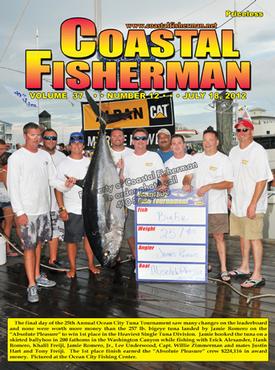


Article by
 The Summer of Flounder by Richard Wong; DE Div. of Fish & Wildlife
The Summer of Flounder by Richard Wong; DE Div. of Fish & Wildlife
It’s July…‘tis the season for fluke fishing. More than half of all Delmarva fluke are brought home in just two months - July and August. It’s no coincidence they’re called summer flounder.
These delectable bottom dwellers are found in tidal creeks, estuaries, and ocean waters all across the continental shelf. Flounder have been found in every State throughout the Atlantic coast and even in the Gulf of Mexico, but its main distribution is from Cape Cod to Cape Hatteras.
Every year, flounder spend the warmer months in shallow estuarine and coastal waters, then move offshore in the fall and winter. They repeat this cycle over a lifespan of about 14 years. Why? For adults, this offshore migration allows breeders to co-mingle with other breeders in a common place and time. Not coincidentally, their breeding congregation is also perfectly timed and situated to bring eggs and larvae back into estuaries by early spring. Juveniles also move offshore in the winter, so there are probably other advantages unrelated to reproduction, like better feeding, lower predation risk, or metabolism benefits.
Interestingly, flounder larvae don’t look or act like a ‘flounder’ but just like any other typical fish. Newly hatched flounder aren’t flat and they don’t live on the seafloor. However, when a larval flounder reaches the estuary, amazingly, its right eye will move next to the left eye while its fins and bones rapidly turn into a flattened fish with a flush top and bottom and eyes on top. They will then drop out of the water column and begin life as a bottom dweller, spending most of its time buried in the sand. That is, except for an occasional ambushing of a sand shrimp, fish, crab or squid.
Flounder is certainly one of our most challenging species to manage. It requires juggling its management between our State and two Federal entities, the Atlantic States Marine Fisheries Commission and Mid-Atlantic Fishery Management Council. We simply refer to them as the ‘Commission’ and ‘Council’.
Flounder from Massachusetts to North Carolina are managed as a single, coastwide stock by the Feds. The Commission manages the coastwide flounder stock within State waters (<3 mi.). Each of those States must manage its flounder fisheries in compliance with the Commission. The Council manages flounder in Federal offshore waters (>3 mi.).
Flounder abundance is monitored by many research surveys performed by the National Marine Fisheries Service (NMFS) and by all nine States in the management unit. With this information, the status of the stock is thoroughly assessed by a team of fishery scientists, every year.
The results of this yearly stock assessment are important. Why? Because it eventually dictates the minimum size, amount and season of the flounder fishery. Let’s explain.
As managers, our goal is to ensure that there are enough baby flounder to grow and replace those that die. We call this, ‘sustainability’, and we strive to maximize it. From the yearly assessment, we get an idea of how many flounder are out there, as well as how many are lost due to harvest and natural causes. Given this info, NMFS (with input from the Council and Commission) sets a harvest quota for the entire coast, to honor that aforementioned goal of maximum sustainability. This annual quota is broken up into smaller pieces by the Council and Commission, eventually making its way to each of the nine States for their recreational harvests. As the stock gets larger or smaller from year-to-year, so accordingly does each State’s quota.
The use of individual quotas allows each State to craft their own recreational measures to keep their harvest under their target. Flounder is the only Council-managed species that uses this management style. But given that the stock naturally varies in abundance from year to year, the ever-changing yearly quota leads to constantly changing size, bag and season regulations in each State. This can be complicated for anglers, and the annual process for us is frankly, demanding - to put it politely.
The Federal process has certainly evolved over the years, but the oversimplified description above has generally been in place for the recreational fishery for the past 11 years. Has it worked? After a history of gross overfishing for two decades through the late 1990’s, fishermen and managers have worked together to trigger a considerable stock recovery in recent years. In fact NMFS declared for the first time ever that the flounder stock was officially rebuilt in 2010.
What’s the future look like? Predicting how many baby flounder will be born in future years is like guessing next year’s weather or stock market prices. Good luck. But you can be sure that as the coastwide flounder stock improves or declines, so will the numbers of fish you will be allowed to keep. As for the management process, things will continue to evolve. Can we move towards multi-year management instead of changing regulations each year? Should we implement the same regulations in all States, or at least across regions? How feasible are slot-limits for fluke? These are existing discussions among managers. Remember, flounder management involves three moving parts, the States, the Commission, and the Council, so change can be challenging. But keep in mind, too, anglers have a lot of opportunity to influence management of their State’s recreational fisheries through public meetings. All States publicize many options for upcoming regulations. Do you favor changing size limits, season closures or bag limits to deal with changing quotas? Attend these meetings and become a part of the discussion. It can perhaps help you to further enjoy your precious slice of summer.